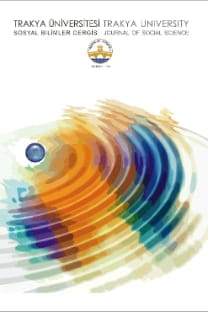Euro ve Dolar Kurları Arasındaki İlişki: Parçalı Durağanlık ve Eşbütünleşme Analizi
Gelişmiş ülkeler 1970’lerin ortalarından itibaren sabit döviz kuru sisteminden esnek döviz kuru sistemine geçmişlerdir. Serbest döviz kuru sistemine geçişle birlikte döviz kuru öngörüleri de önem kazanmıştır. Finans literatüründe uygulamalı çalışmalar göstermiştir ki; döviz kuru serisi dinamikleri birim kök davranışı gösteren zaman serileri şeklindedir. Döviz kurları arasında eşbütünleşme ilişkisinin varlığı uzun dönem bir denge ilişkisi olduğunu göstermektedir ve döviz kurları arasında Granger nedenselliğin olabileceğini işaret etmektedir. Bu bilgilere dayanarak bir döviz kurunun alacağı değeri diğer döviz kuru ile tahminlemek mümkün olabilecektir. Çalışmamızın amacı Euro ve Dolar kurlarının zaman serisi özelliklerini parçalı zaman serisi literatürünü dikkate alarak belirlemek, bu özelliklere dayanarak seriler arasındaki uzun dönem ilişkisini araştırmak, 2001 yılında yaşanan kriz ve politika değişimlerinin kurlar üzerindeki etkisini görmek ve dalgalı kur politikasıyla beraber önem kazanan öngörümlemelerin tutarlılığı hakkında yorumlar sağlamaktır.
The Relationship Between Euro and Dolar Exchange Rates: Fractional Unit Root and Cointegration Analyses
The fixed exchange rate system has been given up and the flexible exchange rate system has been implemented since the mid 1970s in developed countries. Predicting exchange rates gained importance once the implementation of flexible exchange rate systems started. Several applied studies in finance literature show that the exchange rate series have unit roots. The existence of a cointegration relationship between two different exchange rates implies a long run relationship and a possible Granger causality between these different exchange rates. It is possible to predict the value of one exchange rate based on the value of the other one if there is such a long run relationship between them. The aim of our study is to examine the time series properties of the Turkish Liras/Euro and Turkish Liras/Dolar exchange rates and to search for a cointegration relationship considering fractional time series literature. We also try to understand the effects of financial crisis of 2001 and the following policy changes on a possible cointegrating relationship. We will conclude evaluating the consistency of forecasts which became important especially after the implementation of flexible exchange rate systems. Key words: Exchange
___
- ASIKAINEN, A. (2003), “Long Memory and Structural Breaks in Finnish and Swedish Party Popularity Series” http://ethesis.helsinki.fi/julkaisut/val/kansa/disc/586/ longmemo.pdf Erişim: 06.12.2006
- ALPER, C. E. Ve ARDIÇ, O.P. (2006) “Serbest Kur Rejimi Döneminde Döviz Kuru Öngörüsü: Türkiye’ye Uygulama”, Uluslararası Ekonomi ve Dış Ticaret Politikaları, Yıl: 1, Sayı: 1, Sayfa 51-68.
- BARIŞIK, S. ve DEMİRCİOĞLU, E. (2006) “Türkiye’de Döviz Kuru Rejimi Konvertibilete İhracat-İthalat İlişkisi (1980-2001)” Zonguldak Karaelmas Üniversitesi Sosyal Bilimler Dergisi, Cilt 2, Sayı 3, ss 71-84.
- CAPORALE, G. M. ve GILL-ALANA, L. A. (2004), “Fractional Cointegration and Real Exchange Rates” Review of Financial Economics”,13, 327-340.
- CHEUNG Y. ve K. LAI (1993), “A Fractional Cointegration Analysis of Purchasing Power Parity”, Journal of Business and Economic Statistics, 11, 103-112.
- ÇEKEROL, K. ve GÜRBÜZ, H. (2003), “Reel Döviz Kuru Değişimleri ile Sektörel Dış Ticaret Fiyatları Arasındaki Uzun Dönem İlişkisi”,
- ENDERS, W. (2004), “Applied Econometric Time Series”, John Wiley&Sons, USA.
- GEWEKE J. ve PORTER-HUDAK, S. (1983), “The Estimation and Application of Long Memory Time Series Models”, Journal of Time Series Analysis, Vol:4, No:4.
- GILL-ALANA, L. A (2006), “Empirical Evidence Aganist the Exchange Rate Anomaly: The Australian Case” Est. Econ. Sao Pula, Vol:36, No: 2, p.237-250.
- GRANGER, C. ve JOYEUX, R. (1980), “An Introduction to Long-Memory Time Series Models and Fractional Differencing”, Journal of Time Series Analysis, 1, 15-29.
- HALL S. G., (1986), “An Application of the Granger&Engle Two-Step Estimation Procedure to United Kingdom Aggregate Wage Data”, Oxford Bulletin of Economics and Statics, 43, 3.
- HOSKING, J. (1981), “Fractional Differencing”, Biometrika, 68, 165-176.
- KAHYAOĞLU, H. ve ABUK DUYGULU, A. (2005), “Finansal Varlık Fiyatlarındaki Değişme-Parasal Büyüklükler Etkileşimi”, D.E.Ü. İ.İ.B.F. Dergisi, Cilt:20, Sayı:1,ss:63-85.
- KOUSTAS, Z. ve VELOCE, W. (1996), “Unemployment Hysteresis in Canada: An Approach Based on Long-Memory Time Series Models”, Applied Economics, Vol. 28, ss 823- 831.
- LAURINI, M. P. ve PORTUGAL, M. S. (2003), “Long Memory in the R$/US$ Exchange Rate: A Robust Analysis” http://www.ibmecsp.edu.br/pesquisa/download.php?recid=2498 Erişim: 25.12.2006
- OKUR, A. (2002), “Türkiye’de İzlenen Esnek Kur Politikasının Ekonomik İstikrar Üzerindeki Etkileri”, Yönetim ve Ekonomi, Cilt:9, Sayı:1-2.
- ÖNEL, G. (2005), "Testing for Multiple Structural Breaks: An Application of Bai- Perron Test to Nominal Interest Rates and Inflation in Turkey" D.E.Ü. İ.İ.B.F. Dergisi, Cilt:20, Sayı:2, ss:81-93.
- ÖZDEMİR, Z. A. (2003), “Satın Alma Gücü Paritesinin Kesirli Eşbütünleşme Analizi: Türkiye Uygulaması”, VI. Ulusal Ekonometri ve İstatistik Sempozyumu, Gazi Üniversitesi, Ankara.
- ÖZDEMİR, Z. A. (2004), “Mean Reversion in Real Exchange Rate: Emperical Evidence from Turkey, 1980-1999)”, METU Studies in Development, 243-265.
- PAN, M. S. ve LIU, Y. A. (1999), “Fractional Cointegration, Long Memory, and Exchange Rate Dynamics” International Review of Economics and Finance, 8, 305-316.
- SEPHTON, P. S. (1996), “A Note on Fractional Cointegration”, Applied Economics Letters, 3, 683-685.
- SEPHTON, P. S. (2002), “Fractional Cointegration: Monte Carlo Estimates of Critical Values with An Aplication” Applied Financial Economics, 12, 331-335.
- STEFFENSMEIER, J. M. ve SMITH, R. M. (1998), “Investigation Political Dynamics Using Fractional Integration Methods”, American Journal of Political Science, Vol: 42, No:2,pp.661-669.
- TURGUTLU, Evrim (2004), “Fisher Hipotezinin Tutarlığının Testi: Parçalı Durağanlık ve Parçalı Koentegrasyon Analizi”, D.E.Ü. İ.İ.B.F. Dergisi, Cilt:19, Sayı:2, ss:55-74
- ZIVOT, E. ve ANDREWS, D. W. K., (1992), “Further Evidence on the Great Crash, the Oil-Price Shock, and the Unit-Root Hypotesis”, Journal of Business&Economic Statics, Vol:10, No: 3.
- http://tr.wikipedia.org/wiki/D%C3%B6viz
- www.tcmb.gov.tr
- ISSN: 1305-7766
- Yayın Aralığı: Yılda 2 Sayı
- Başlangıç: 2000
- Yayıncı: Trakya Üniversitesi Sosyal Bilimler Enstitüsü
Sayıdaki Diğer Makaleler
Performans Değerlendirme Sistemi ve Kullanım Alanları
MEHMET AKİF’İN ŞİİRLERİNDE HALK AĞZI
Medya Irak'ta Adil Davranıyor mu?
Annelere İlişkin Bazı Değişkenlerin 5-6 Yaş Çocuklarının Yaratıcı Düşüncelerine Etkisi
ORKESTRA PROVALARINDA ZAMAN FAKTÖRÜ
Trakya Üniversitesi Eğitim Fakültesi Sınıf Öğretmenliği Mezunu Öğretmenlerin Program Değerlendirmesi
ANLATISAL METİNLER VE KISA ÖYKÜ
